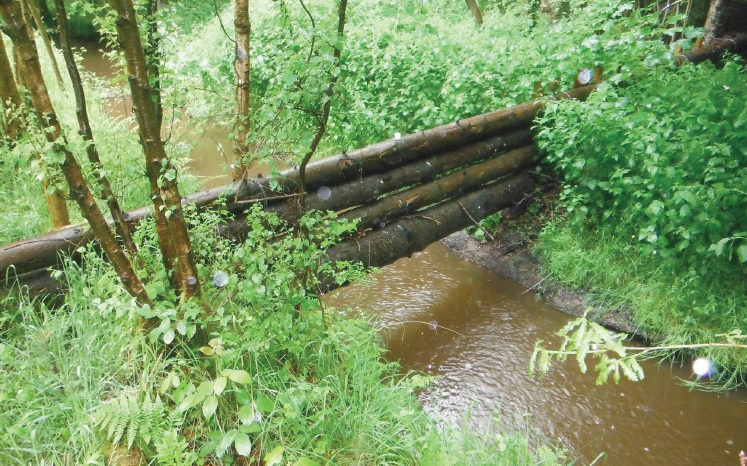Leaky barrier retention times for Natural Flood Management interventions
Design tool to support modelling of leaky barriers
Elizabeth M. Follett, Royal Academy of Engineering Research Fellow at Liverpool University, and Keith Beven, Emeritus Professor of Hydrology, Lancaster University
Quick Summary
One of the strategies for natural flood management in the UK is the use of instream barriers to retain water during flood events with the aim of reducing event magnitude and associated damages due to flooding of houses and businesses. However, the quantitative design and assessment of leaky barrier designs has not been widely available and few projects have incorporated the concept of retention time into barrier and project design.
This spreadsheet design tool links the barrier structural design to backwater volume and increase in retention time, allowing exploration of the impact of varying barrier and channel structural parameters during the design phase or for the post-hoc evaluation of existing barriers. The tool provides a quick and accessible analysis that can support modelling of leaky barriers across different levels of detail, from simple site assessment through to intermediate or detailed models (as discussed, for example, in the CIRIA Natural Flood Management Manual, CIRIA, 2022, Table 14.6 – see Potential uses of the tool, below).
Origins of the design tool
Metcalfe et al. (2018) demonstrated how reduction in flood peak magnitude can be linked to the structure-generated retention time and design of the structures used. If barriers filled and drained too quickly, the effect would be minimal, even for large potential amounts of storage. In this case, the retention time in the storage was too short. However, if barriers filled but did not drain between events, then a sequence of rain events before a major flood peak filled available storage so that the effect on the major flood peak was minimal (simulation based on period encompassing Storms Abigail, Barney, and Desmond, late September—mid December 2015). In this case, the retention time in the storage was too long.
The modelling results of Metcalfe et al. (2018) suggested that a mean retention time of 1 hour was too short, and that a mean retention time of 100 hours was too long across the Eden headwater catchments of 223 km² in north west England. However, a retention time on the order of 10 hours produced a significant reduction in a flood peak for a simulation of Storm Desmond (5-6 December 2015), a storm that produced record-breaking rainfall and major flood damages (Met Office 2015, BBC 2015, Environment Agency, 2018). More recent work has also reinforced the requirement for large amounts of storage to be made available with retention times on the order of 10h for performance in peak flow reduction to be practically significant (Beven et al., 2022). It has been shown using a system-based analysis (Hankin et al. 2020) that a selective placement of leaky barriers where they are most effective can be worthwhile in maximising flood risk reduction benefits and minimising costs. So, the question is: how can that effectiveness be assessed?
In examining the impact of a pilot natural flood management project with field monitoring evidence, analysis of leaky barriers at Tebay Gill, Cumbria, UK (Mindham et al. 2023, Follett et al. 2023) suggests that the dynamics of the storage volumes generated by leaky barriers and other runoff attenuation features are more important than the slowing of the flood wave celerities. The Metcalfe et al. (2018) simulations discussed above used a similar assumption, treating each of many thousands of storage elements in the catchment as a linear store with an assumed time constant. Based on these results, a spreadsheet design tool was developed to promote quantitative assessment of the impact of leaky barrier installations on retention time and assist design and assessment of natural flood management projects.
Here, the leaky barrier storage dynamics are linked to barrier and channel physical characteristics, allowing for underflow, seepage and weir overtopping under steady flow conditions. Flow through a leaky barrier generates momentum loss proportional to the number, size, and packing density of the logs comprising the structure (Follett et al. 2020), elevating the water depth upstream of the barrier relative to unobstructed open channel flow. The distribution of flow through and beneath the barrier satisfies a two-box, momentum-based model constrained by drag generated in the barrier, momentum loss in flow through the lower gap, and net pressure force (Follett et al. 2021).
The design tool provides output graphics and figures that allow the retention times of a leaky barrier to be rapidly assessed for different flow rates, that can be varied with the ratio of depth of flow to bankfull depth. It also provides outputs for the unobstructed flow case for comparison. The input design parameters can be easily varied to see the effect on the resulting storage and retention times at different flow rates. It is hoped that the availability of the tool will allow more account to be taken of retention times in NFM projects that involve barriers of this type.
Download the tool here: DesignTool_leakybarrierretentiontimes_FollettBeven2023
The design tool Excel file contains four sheets, including description of calculations, user-entered input, output plots and values controlled by a discharge slider, and model calculations.
Notes on sources and methodology
The tool was designed with a sparse data input scheme to facilitate general use, even in the absence of detailed site survey data. A compound trapezoidal channel is assumed, based on specification of the channel bottom width, bankfull width and depth (and estimated width of the channel 1 m above bankfull depth) (Figure 1, “Input” sheet). Uniform flow discharge is related to water depth from user choice of bed resistance model, including dimensionless friction coefficient, Chézy coefficient, Manning’s, estimate of bed friction from median sediment diameter and bankfull depth, and estimate of bed friction from channel slope using regression relationships (Parker et al. 2007, Follett and Hankin 2022).
The model accommodates leaky barriers that span the vertical distance of the channel and barriers with a lower underflow gap (Follett et al. 2020, 2021). Flow over the leaky barrier once the storage has reached the top of the structure is assumed to follow a sharp-crested weir relationship (Munson et al. 2013, Hankin et al. 2020). To reduce the amount of input data and facilitate a broad user base, the dimensionless structural parameter specifying “leakiness” of the leaky barrier is related to the relative magnitude of the backwater rise for a channel-spanning leaky barrier with no lower gap, (Follett et al. 2020). The height of the barrier lower and upper edges above the bed () are used to specify the barrier vertical extent. The barrier backwater volume above unobstructed uniform low is found using a simplified triangular shape (Hankin et al. 2020, Follett and Hankin 2022) related to barrier structure, channel slope and uniform flow depth. Further details are included on a sub-sheet in the design tool and are published in Follett et al. (2023) including an analysis of barriers at Tebay Gill.
Potential uses of the tool
The design tool can be used to assess potential impact of leaky barrier designs before installation, or to compare predicted barrier impact, for example the change in water surface level over the barrier and associated generation of backwater storage and change in retention time, for existing leaky barriers. The sparse data input scheme and user choice of bed resistance model allows for a wide range of potential users.
Design practitioners could use the tool to evaluate the impact of varying leaky barrier design characteristics, such as height of the barrier lower and upper edges, on barrier-generated retention time under varying flow conditions. The tool can also be used for post-hoc evaluation of existing barriers.
Non-specialists may wish to use the tool to support self-design of leaky barrier interventions. A sparse data input scheme has been adopted, including example site characteristics to support use as an estimation tool with limited input data.
References
BBC, 2015. Storm Desmond: Thousands of people flooded out of homes. 7 December 2015. Accessed 27 March 2023. https://www.bbc.co.uk/news/uk-35023558
Beven, K.J., Page, T., Hankin, B., Smith, P., Kretzschmar, A., Mindham, D., and Chappell, N. A., 2022. Deciding on fitness-for-purpose – of models and of natural flood management, Hydrological Processes 36 (11), https://doi.org/10.1002/hyp.14752.
CIRIA, 2022, The natural flood management manual, CIRIA publication C802F
Environment. Agency, 2018, Floods of winter 2015 to 2016: estimating the costs – GOV.UK (www.gov.uk)
Follett, E., Beven, K., Hankin, B., Mindham, D., Chappell, N., 2023. The importance of retention times in Natural Flood Management interventions. Proceedings of the International Association of Hydrological Sciences, under review.
Follett, E., Hankin, H., 2022. Investigation of effect of logjam series for varying channel and barrier physical properties using a sparse input data 1D network model. Environmental Modelling and Software 158, 105543. https://doi.org/10.1016/j.envsoft.2022.105543
Follett, E., Schalko, I., Nepf, H. 2020. Momentum and energy predict the backwater rise generated by a large wood jam. Geophysical Research Letters 47, e2020GL089346. https://doi.org/10.1029/2020GL089346
Follett, E., Schalko, I., Nepf, H. 2021. Logjams with a lower gap: Backwater rise and flow distribution beneath and through logjam predicted by two-box momentum balance. Geophysical Research Letters 48, e2021GL094279. https://doi.org/10.1029/2021GL094279
Hankin, B., Hewitt, I., Sander, G., Danieli, F., Formetta, G., Kamilova, A., Kretzschmar, A., Kiradjiev, K., Wong, C., Pegler, S., and Lamb, R., 2020. A risk-based network analysis of distributed in-stream leaky barriers for flood risk management, Nat. Hazards Earth Syst. Sci., 20, 2567–2584, https://doi.org/10.5194/nhess-20-2567-2020
Met Office, 2015. Storm Desmond. Accessed 27 March 2023. https://www.metoffice.gov.uk/weather/warnings-and-advice/uk-storm-centre/storm-desmond
Metcalfe, P, Beven, K J, Hankin, B and Lamb, R., 2018, A new method, with application, for analysis of the impacts on flood risk of widely distributed enhanced hillslope storage, Hydrology and Earth System Science, 22: 2589-2605, https://doi.org/10.5194/hess-22-2589-2018.
Mindham, D., Beven, K.J. and Chappell, N.A,, 2023, Rainfall–streamflow response times for diverse upland UK micro-basins: quantifying hydrographs to identify the nonlinearity of storm response, Hydrology Research, nh2023115, https://doi.org/10.2166/nh.2023.115
Parker, G., Wilcock, P., Paola, C., Dietrich, W., Pitlick, J., 2007. Physical basis for quasi- universal relations describing bankfull hydraulic geometry of single-thread gravel bed rivers. J. Geophys. Res. 112, F04005 https://doi.org/10.1029/2006JF000549


